Munson B.R. Fundamentals of Fluid Mechanics
Подождите немного. Документ загружается.


9.3.3 Drag Coefficient Data and Examples
As was discussed in previous sections, the net drag is produced by both pressure and shear stress
effects. In most instances these two effects are considered together, and an overall drag coefficient,
as defined in Eq. 9.36 is used. There is an abundance of such drag coefficient data available
in the literature. This information covers incompressible and compressible viscous flows past ob-
jects of almost any shape of interest—both man-made and natural objects. In this section we con-
sider a small portion of this information for representative situations. Additional data can be ob-
tained from various sources 1Refs. 5, 62.
Shape Dependence. Clearly the drag coefficient for an object depends on the shape of
the object, with shapes ranging from those that are streamlined to those that are blunt. The drag
on an ellipse with aspect ratio where D and are the thickness and length parallel to the
flow, illustrates this dependence. The drag coefficient based on the frontal
area, where b is the length normal to the flow, is as shown in Fig. 9.19. The more blunt
the body, the larger the drag coefficient. With 1i.e., a flat plate normal to the flow2we
obtain the flat plate value of With the corresponding value for a circular cylin-
der is obtained. As becomes larger the value of decreases.
For very large aspect ratios the ellipse behaves as a flat plate parallel to the flow.
For such cases, the friction drag is greater than the pressure drag, and the value of based on the
frontal area, would increase with increasing 1This occurs for larger values than
those shown in the figure.2For such extremely thin bodies 1i.e., an ellipse with a flat plate,
or very thin airfoils2it is customary to use the planform area, in defining the drag coefficient.A b/,
/
D S ,
/
D/
D.A bD,
C
D
1/
D S 2
C
D
/
D
/
D 1C
D
1.9.
/
D 0
A bD,
C
D
d
1rU
2
bD
22,
//
D,
C
D
,
9.3 Drag 497
F I G U R E E9.9
COMMENT It is of interest to compare the friction drag to
the total drag on the cylinder. That is,
d
f
d
C
Df
C
D
5.93
1Re
15.93
1Re2 1.17
1
1 0.1971Re
For and this ratio is 0.138, 0.0483, and 0.0158,
respectively. Most of the drag on the blunt cylinder is pressure
drag—a result of the boundary layer separation.
10
5
Re 10
3
, 10
4
,
Experimental value
Eq. 2
10
6
10
5
10
4
10
3
10
2
10
1
10
0
0.1
1.0
10
100
Re =
UD
___
v
(c)
(
a)
(
b)
C
D
0
-1.5
-1.0
-0.5
0
0.5
1.0
30 60 90 120 150 180
θ
, degrees
C
p
=
_____
p - p
o
1
_
2
U
2
ρ
ππ
3 ___
4
π
__
2
π
__
4
0
-0.5
0
0.5
1.0
, rad
θ
θ
C
p
cos
The drag coefficient
may be based on
the frontal area or
the planform area.
V9.7 Skydiving
practice
JWCL068_ch09_461-533.qxd 9/23/08 11:48 AM Page 497

After all, it is the planform area on which the shear stress acts, rather than the much smaller 1for thin
bodies2frontal area. The ellipse drag coefficient based on the planform area, is
also shown in Fig. 9.19. Clearly the drag obtained by using either of these drag coefficients would be
the same. They merely represent two different ways to package the same information.
The amount of streamlining can have a considerable effect on the drag. Incredibly, the drag
on the two two-dimensional objects drawn to scale in Fig. 9.20 is the same. The width of the wake
for the streamlined strut is very thin, on the order of that for the much smaller diameter circular
cylinder.
Reynolds Number Dependence. Another parameter on which the drag coefficient can
be very dependent is the Reynolds number. The main categories of Reynolds number dependence
are 112very low Reynolds number flow, 122moderate Reynolds number flow 1laminar boundary
layer2, and 132very large Reynolds number flow 1turbulent boundary layer2. Examples of these three
situations are discussed below.
Low Reynolds number flows are governed by a balance between viscous and pres-
sure forces. Inertia effects are negligibly small. In such instances the drag on a three-
dimensional body is expected to be a function of the upstream velocity, U, the body size, and
the viscosity, Thus, for a small grain of sand settling in a lake 1see margin figure2
From dimensional considerations 1see Section 7.7.12
(9.38)
where the value of the constant C depends on the shape of the body. If we put Eq. 9.38 into di-
mensionless form using the standard definition of the drag coefficient, we obtain
C
D
⫽
d
1
2
rU
2
/
2
⫽
2Cm/U
rU
2
/
2
⫽
2C
Re
d ⫽ Cm/U
d ⫽ f 1U, /, m2
m.
/,
1Re 6 12
C
D
⫽ d
Ⲑ
1rU
2
b/
Ⲑ
22,
498 Chapter 9 ■ Flow over Immersed Bodies
F I G U R E 9.20 Two objects of considerably different size that have the same drag force:
(a) circular cylinder C
D
ⴝ 1.2; (b) streamlined strut C
D
ⴝ 0.12.
F I G U R E 9.19 Drag coefficient
for an ellipse with the characteristic area either
the frontal area, A ⴝ bD, or the planform area,
A ⴝ b (Ref. 5)./
2.5
2.0
1.5
1.0
0.5
0
0123456
D
U
Flat plate
parallel to flow
D
C
D
Re = = 10
5
UD
v
b
= length
U
2
bD
1
2
C
D
=
•
U
2
b
1
2
C
D
=
Flat plate
normal to flow
ρ
ρ
U,
ρ
U,
ρ
Diameter = D
(a)(b)
10
D
a
=
b
U
= f(U, , )
Re < 1
JWCL068_ch09_461-533.qxd 9/23/08 11:48 AM Page 498
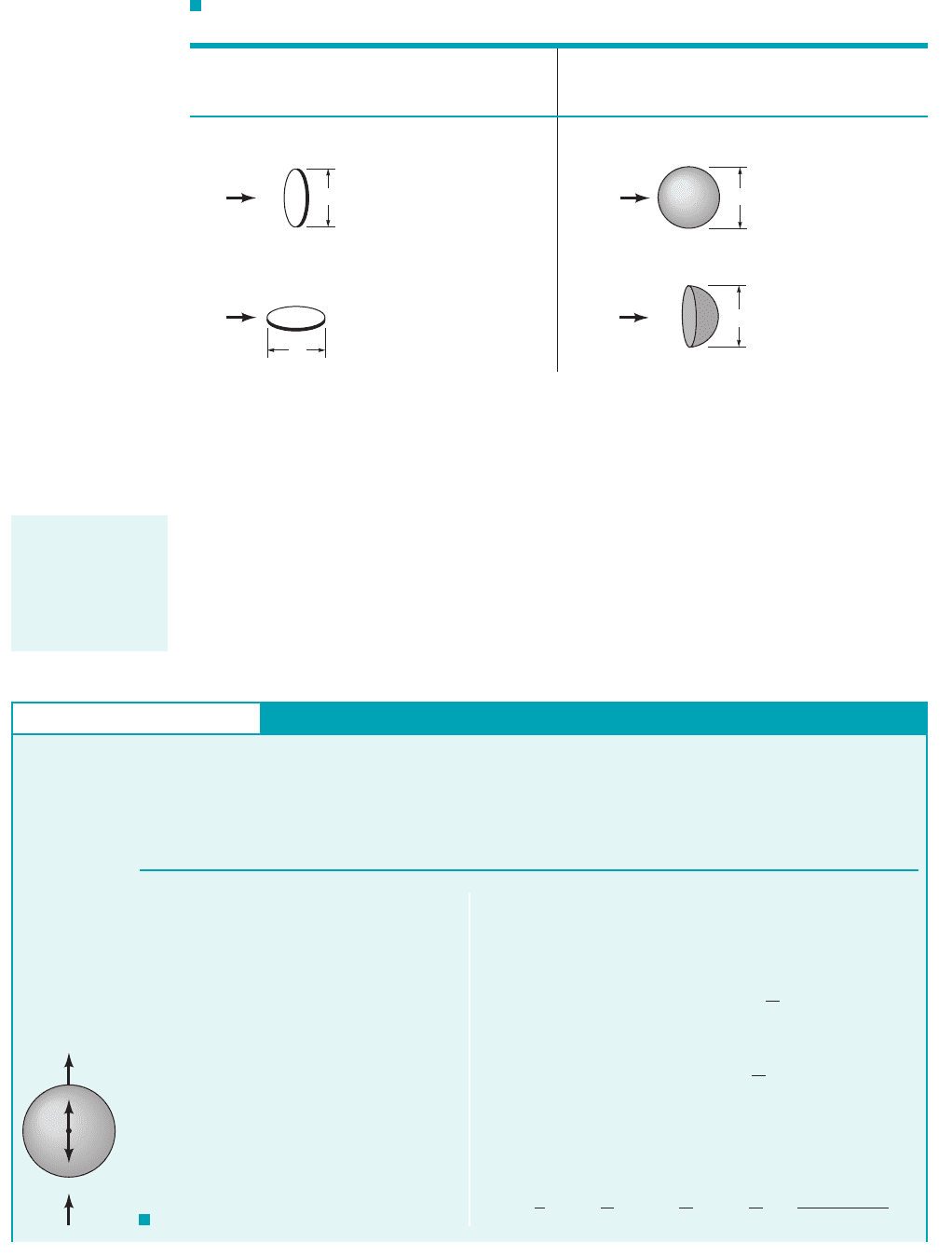
where The use of the dynamic pressure, in the definition of the drag coeffi-
cient is somewhat misleading in the case of creeping flows because it introduces the
fluid density, which is not an important parameter for such flows 1inertia is not important2. Use of
this standard drag coefficient definition gives the dependence for small Re drag coefficients.
Typical values of for low Reynolds number flows past a variety of objects are given in
Table 9.4. It is of interest that the drag on a disk normal to the flow is only 1.5 times greater than
that on a disk parallel to the flow. For large Reynolds number flows this ratio is considerably larger
1see Example 9.12. Streamlining 1i.e., making the body slender2can produce a considerable drag
reduction for large Reynolds number flows; for very small Reynolds number flows it can actually
increase the drag because of an increase in the area on which shear forces act. For most objects,
the low Reynolds number flow results are valid up to a Reynolds number of about 1.
C
D
1
Ⲑ
Re
1Re 6 12
rU
2
Ⲑ
2,Re ⫽ rU/
Ⲑ
m.
9.3 Drag 499
For very small
Reynolds number
flows, the drag co-
efficient varies in-
versely with the
Reynolds number.
TABLE 9.4
Low Reynolds Number Drag Coefficients (Ref. 7) ( )
()
Object ( ) Object
a. Circular disk normal c. Sphere
to flow
b. Circular disk parallel d. Hemisphere
to flow
22.2
Ⲑ
Re13.6
Ⲑ
Re
24.0
Ⲑ
Re20.4
Ⲑ
Re
C
D
for Re f 1
RU
2
A
Ⲑ
2C
D
ⴝ d
Ⲑ
Re ⴝ RUD
Ⲑ
M, A ⴝ PD
2
Ⲑ
4
U
D
U
D
U
D
U
D
GIVEN A small grain of sand, diameter and
specific gravity settles to the bottom of a lake after
having been stirred up by a passing boat.
SG ⫽ 2.3,
D ⫽ 0.10 mm
S
OLUTION
Low Reynolds Number Flow Drag
From the free-body diagram, we obtain
where
(1)
and
(2)
We assume 1because of the smallness of the object2that the
flow will be creeping flow with 1see Table
9.42so that
d ⫽
1
2
r
H
2
O
U
2
p
4
D
2
C
D
⫽
1
2
r
H
2
O
U
2
p
4
D
2
a
24
r
H
2
O
UD
Ⲑ
m
H
2
O
b
C
D
⫽ 24
Ⲑ
Re1Re 6 12
F
B
⫽ g
H
2
O
V⫺⫽g
H
2
O
p
6
D
3
w ⫽ g
sand
V⫺⫽SG g
H
2
O
p
6
D
3
w ⫽ d ⫹ F
B
E
XAMPLE 9.10
A free-body diagram of the particle 1relative to the moving particle2
is shown in Fig. E9.10a. The particle moves downward with a con-
stant velocity U that is governed by a balance between the weight
of the particle, the buoyancy force of the surrounding water,
and the drag of the water on the particle, d.
F
B
,w,
FIND Determine how fast it falls through the still water.
F
B
U
F I G U R E E9.10
a
JWCL068_ch09_461-533.qxd 9/23/08 11:48 AM Page 499

Moderate Reynolds number flows tend to take on a boundary layer flow structure. For such
flows past streamlined bodies, the drag coefficient tends to decrease slightly with Reynolds num-
ber. The dependence for a laminar boundary layer on a flat plate 1see Table 9.32is
such an example. Moderate Reynolds number flows past blunt bodies generally produce drag co-
efficients that are relatively constant. The values for the spheres and circular cylinders shown
in Fig. 9.21a indicate this character in the range
The structure of the flow field at selected Reynolds numbers indicated in Fig. 9.21a is shown
in Fig. 9.21b. For a given object there is a wide variety of flow situations, depending on the Reynolds
number involved. The curious reader is strongly encouraged to study the many beautiful pho-
tographs and videos of these 1and other2flow situations found in Refs. 8 and 31. (See also the pho-
tograph at the beginning of Chapter 7.)
For many shapes there is a sudden change in the character of the drag coefficient when the
boundary layer becomes turbulent. This is illustrated in Fig. 9.15 for the flat plate and in Fig. 9.21
for the sphere and the circular cylinder. The Reynolds number at which this transition takes place
is a function of the shape of the body.
For streamlined bodies, the drag coefficient increases when the boundary layer becomes tur-
bulent because most of the drag is due to the shear force, which is greater for turbulent flow than
for laminar flow. On the other hand, the drag coefficient for a relatively blunt object, such as a
cylinder or sphere, actually decreases when the boundary layer becomes turbulent. As is discussed
in Section 9.2.6, a turbulent boundary layer can travel further along the surface into the adverse
pressure gradient on the rear portion of the cylinder before separation occurs. The result is a thin-
ner wake and smaller pressure drag for turbulent boundary layer flow. This is indicated in Fig. 9.21
10
3
6 Re 6 10
5
.
C
D
C
D
⬃ Re
1
2
500 Chapter 9 ■ Flow over Immersed Bodies
or
(3)
We must eventually check to determine if this assumption 1Re 12
is valid or not. Equation 3 is called Stokes’s law in honor of G. G.
Stokes 11819–19032, a British mathematician and physicist. By
combining Eqs. 1, 2, and 3, we obtain
or, since
(4)
From Table 1.6 for water at we obtain
and Thus, from Eq. 4 we obtain
or
(Ans)
Since
we see that and the form of the drag coefficient used is
valid.
Re 6 1,
0.564
Re
rDU
m
1999 kg
m
3
210.10 10
3
m210.00632 m
s2
1.12 10
3
N
#
s
m
2
U 6.32 10
3
m
s
U
12.3 121999 kg
m
3
219.81 m
s
2
210.10 10
3
m2
2
1811.12 10
3
N
#
s
m
2
2
N
#
s
m
2
.m
H
2
O
1.12 10
3
r
H
2
O
999 kg
m
3
15.6 °C
U
1SG 12r
H
2
O
gD
2
18 m
g rg,
SG g
H
2
O
p
6
D
3
3pm
H
2
O
UD g
H
2
O
p
6
D
3
d 3pm
H
2
O
UD
COMMENTS By repeating the calculations for various parti-
cle diameters, D, the results shown in Fig. E9.10b are obtained.
Note that very small particles fall extremely slowly. Thus, it can
take considerable time for silt to settle to the bottom of a river or
lake.
Note that if the density of the particle were the same as the sur-
rounding water (i.e., SG 1), from Eq. 4 we would obtain
This is reasonable since the particle would be neutrally
buoyant and there would be no force to overcome the motion-
induced drag. Note also that we have assumed that the particle falls
at its steady terminal velocity. That is, we have neglected the ac-
celeration of the particle from rest to its terminal velocity. Since
the terminal velocity is small, this acceleration time is quite small.
For faster objects 1such as a free-falling sky diver2it may be im-
portant to consider the acceleration portion of the fall.
U 0.
F I G U R E E9.10
b
0.007
0.006
0.005
0.004
0.003
0.002
0.001
0
0 0.02 0.04
D, mm
U, m/s
0.06 0.08 0.1
(0.10 mm, 6.32 × 10
–3
m/s)
Flow past a cylin-
der can take on a
variety of different
structures.
V9.8 Karman
vortex street
JWCL068_ch09_461-533.qxd 9/23/08 11:48 AM Page 500
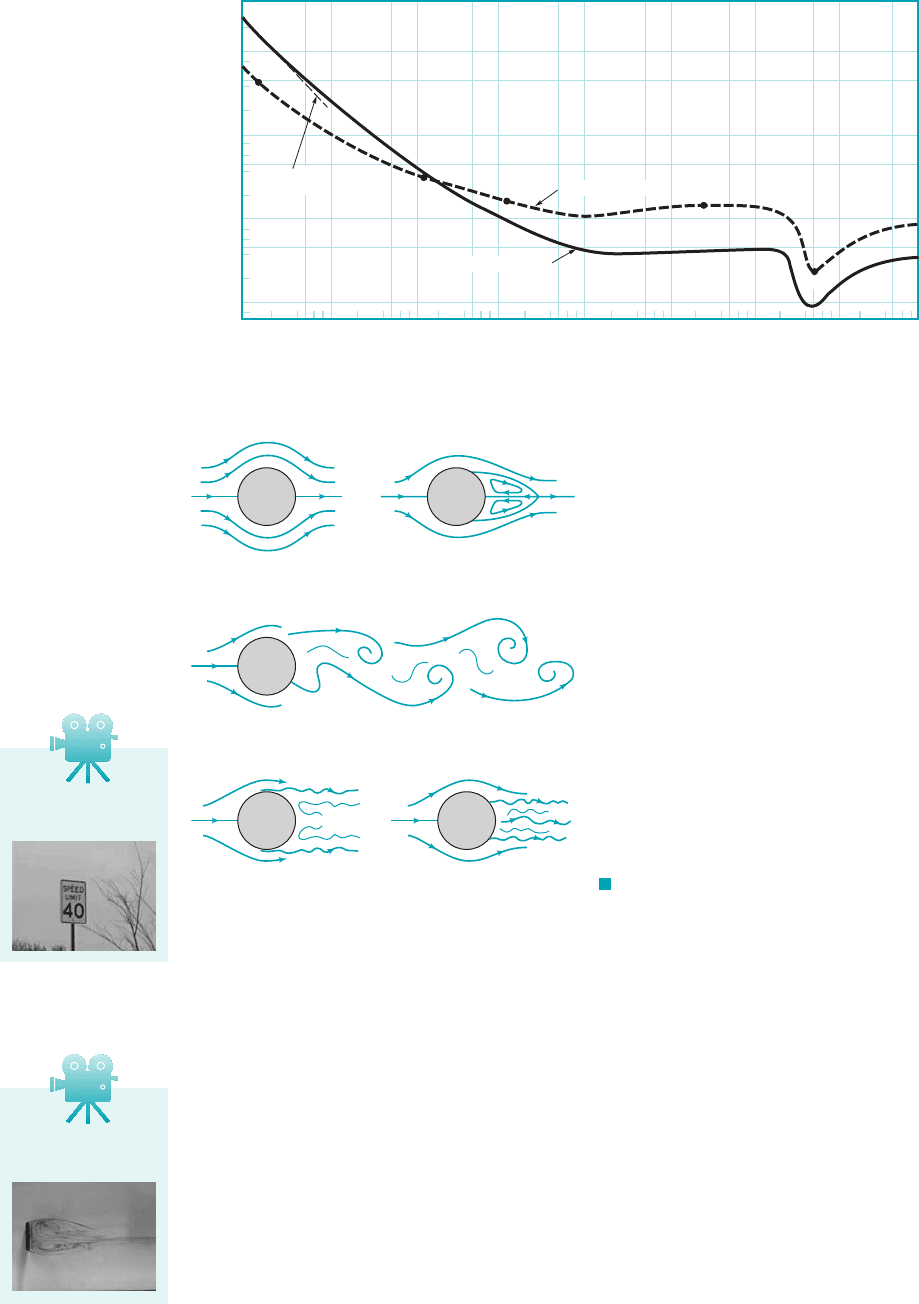
by the sudden decrease in for In a portion of this range the actual drag 1not
just the drag coefficient2decreases with increasing speed. It would be very difficult to control the
steady flight of such an object in this range—an increase in velocity requires a decrease in thrust
1drag2. In all other Reynolds number ranges the drag increases with an increase in the upstream ve-
locity 1even though may decrease with Re2.
For extremely blunt bodies, like a flat plate perpendicular to the flow, the flow separates at
the edge of the plate regardless of the nature of the boundary layer flow. Thus, the drag coefficient
shows very little dependence on the Reynolds number.
The drag coefficients for a series of two-dimensional bodies of varying bluntness are
given as a function of Reynolds number in Fig. 9.22. The characteristics described above are
evident.
C
D
10
5
6 Re 6 10
6
.C
D
9.3 Drag 501
A
B
C
D
E
Smooth cylinder
Smooth sphere
C
D
=
24
___
Re
400
200
100
60
40
20
10
6
4
2
1
0.6
0.4
0.2
0.1
0.06
10
–1
10
0
10
1
10
2
10
3
10
4
10
5
10
6
10
7
Re =
UD
____
ρ
μ
(a)
C
D
No separation
(
A)
Steady separation bubble
(
B)
Oscillating Karman vortex street wake
(
C)
Laminar boundary layer,
wide turbulent wake
(
D)
Turbulent boundary layer,
narrow turbulent wake
(E)
(
b)
F I G U R E 9.21 (a) Drag coefficient as
a function of Reynolds number for a smooth circular
cylinder and a smooth sphere. (b) Typical flow pat-
terns for flow past a circular cylinder at various
Reynolds numbers as indicated in (a).
V9.10 Flow past a
flat plate
V9.9 Oscillating
sign
JWCL068_ch09_461-533.qxd 9/23/08 11:48 AM Page 501
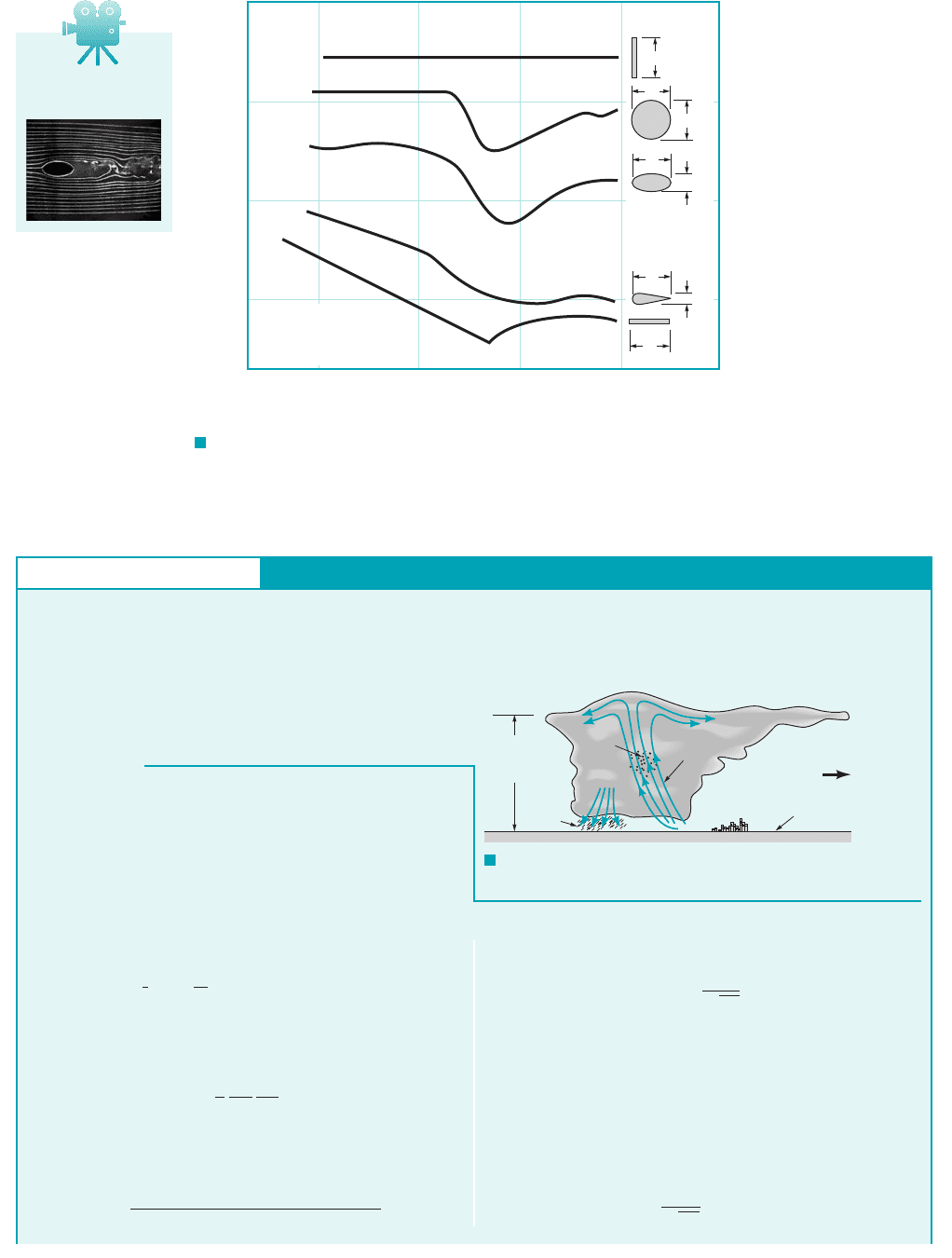
502 Chapter 9 ■ Flow over Immersed Bodies
Flat plate
Circle
Ellipse
Airfoil
Flat plate
C
D
=
Ᏸ
_________
U
2
bD
1
__
2
ρ
D
D
0.18 D
0.5 D
D
D
D
D
1.0
0.1
0.01
C
D
10
4
10
5
10
6
10
7
Re =
UD
___
v
b
= length
F I G U R E 9.22 Character of the drag coefficient as a function
of Reynolds number for objects with various degrees of streamlining, from a
flat plate normal to the upstream flow to a flat plate parallel to the flow (two-
dimensional flow) (Ref. 5).
V9.11 Flow past an
ellipse
GIVEN Hail is produced by the repeated rising and falling of
ice particles in the updraft of a thunderstorm, as is indicated in
Fig. E9.11a. When the hail becomes large enough, the aerody-
namic drag from the updraft can no longer support the weight of
the hail, and it falls from the storm cloud.
S
OLUTION
F I G U R E E9.11
a
Terminal Velocity of a Falling Object
or
(3)
where U is in To determine U, we must know Unfortu-
nately, is a function of the Reynolds number 1see Fig. 9.212,
which is not known unless U is known. Thus, we must use an it-
erative technique similar to that done with the Moody chart for
certain types of pipe flow problems 1see Section 8.52.
From Fig. 9.21 we expect that is on the order of 0.5. Thus,
we assume and from Eq. 3 obtain
U
64.5
10.5
91.2 ft
s
C
D
0.5
C
D
C
D
C
D
.ft
s.
U
64.5
1C
D
Anvil
Storm
movement
Ground
Hail
Updraft
Rain
40,000
to
50,000 ft
Down
draft
E
XAMPLE 9.11
As is discussed in Example 9.10, for steady-state conditions a
force balance on an object falling through a fluid at its terminal
velocity, U, gives
where is the buoyant force of the air on the particle,
is the particle weight, and is the aerodynamic drag.
This equation can be rewritten as
(1)
With and since 1i.e., 2, Eq. 1 can
be simplified to
(2)
By using and
Eq. 2 becomes
U c
411.84 slugs
ft
3
2132.2 ft
s
2
210.125 ft2
312.38 10
3
slugs
ft
3
2C
D
d
1
2
D 1.5 in. 0.125 ft,
r
ice
1.84 slugs
ft
3
, r
air
2.38 10
3
slugs
ft
3
,
U a
4
3
r
ice
r
air
gD
C
D
b
1
2
w F
B
g
ice
g
air
VpD
3
6
1
2
r
air
U
2
p
4
D
2
C
D
w F
B
dw g
ice
V
F
B
g
air
V
w d F
B
FIND Estimate the velocity, U, of the updraft needed to make
-in.-diameter 1i.e., “golf ball-sized”2hail.D 1.5
JWCL068_ch09_461-533.qxd 9/23/08 11:48 AM Page 502
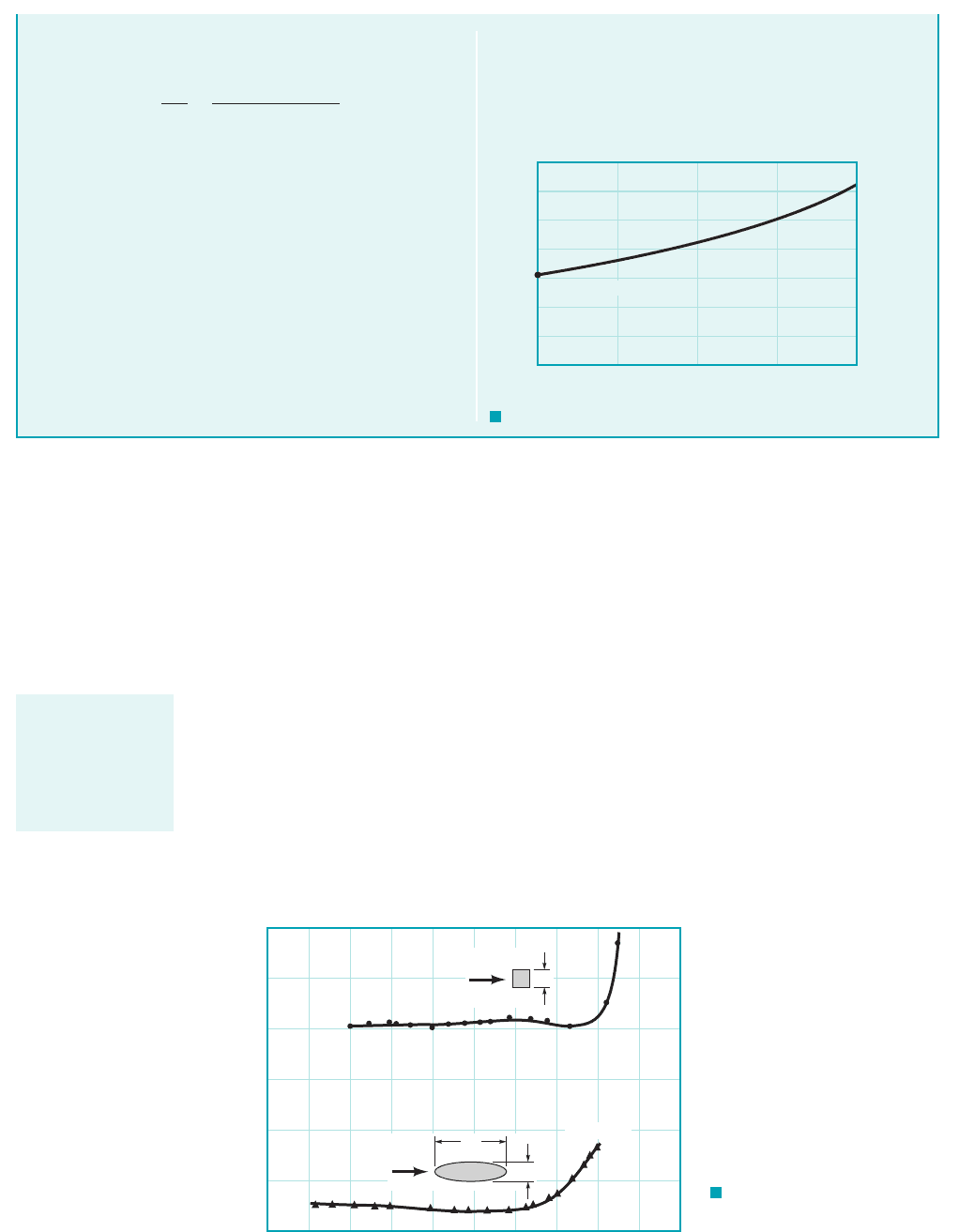
Compressibility Effects. The above discussion is restricted to incompressible flows. If
the velocity of the object is sufficiently large, compressibility effects become important and the
drag coefficient becomes a function of the Mach number, where c is the speed of sound
in the fluid. The introduction of Mach number effects complicates matters because the drag
coefficient for a given object is then a function of both Reynolds number and Mach number—
The Mach number and Reynolds number effects are often closely connected be-
cause both are directly proportional to the upstream velocity. For example, both Re and Ma in-
crease with increasing flight speed of an airplane. The changes in due to a change in U are due
to changes in both Re and Ma.
The precise dependence of the drag coefficient on Re and Ma is generally quite complex
1Ref. 132. However, the following simplifications are often justified. For low Mach numbers, the
drag coefficient is essentially independent of Ma as is indicated in Fig. 9.23. For this situation, if
or so, compressibility effects are unimportant. On the other hand, for larger Mach num-
ber flows, the drag coefficient can be strongly dependent on Ma, with only secondary Reynolds
number effects.
For most objects, values of increase dramatically in the vicinity of 1i.e., sonic
flow2. This change in character, indicated by Fig. 9.24, is due to the existence of shock waves as
Ma ⫽ 1C
D
Ma 6 0.5
C
D
C
D
⫽ f1Re, Ma2.
Ma ⫽ U
Ⲑ
c,
9.3 Drag 503
The corresponding Reynolds number 1assuming
2is
For this value of Re we obtain from Fig. 9.21, Thus,
our assumed value of was correct. The corresponding
value of U is
(Ans)
COMMENTS By repeating the calculations for various alti-
tudes, z, above sea level (using the properties of the U.S. Standard
Atmosphere given in Appendix C), the results shown in Fig.
E9.11b are obtained. Because of the decrease in density with alti-
tude, the hail falls even faster through the upper portions of the
storm than when it hits the ground.
Clearly, an airplane flying through such an updraft would feel
its effects 1even if it were able to dodge the hail2. As seen from
Eq. 2, the larger the hail, the stronger the necessary updraft.
U ⫽ 91.2 ft
Ⲑ
s ⫽ 62.2 mph
C
D
⫽ 0.5
C
D
⫽ 0.5.
Re ⫽
UD
n
⫽
91.2 ft
Ⲑ
s 10.125 ft2
1.57 ⫻ 10
⫺4
ft
2
Ⲑ
s
⫽ 7.26 ⫻ 10
4
10
⫺4
ft
2
Ⲑ
s
v ⫽ 1.57 ⫻
Hailstones greater than 6 in. in diameter have been reported. In re-
ality, a hailstone is seldom spherical and often not smooth. How-
ever, the calculated updraft velocities are in agreement with mea-
sured values.
F I G U R E E9.11
b
z, ft
U, mph
(0, 62.2 mph)
140
120
100
80
60
40
20
0
0 10,000 20,000 30,000 40,000
4D
U
D
U
D
0.5 1.0
b = length
0
Ma
3.0
2.5
2.0
1.5
1.0
0.5
0
C
D
=
Ᏸ
__________
U
2
bD
1
__
2
ρ
The drag coefficient
is usually indepen-
dent of Mach num-
ber for Mach
numbers up to ap-
proximately 0.5.
F I G U R E 9.23
Drag coefficient as a func-
tion of Mach number for
two-dimensional objects in
subsonic flow (Ref. 5).
JWCL068_ch09_461-533.qxd 9/23/08 11:48 AM Page 503
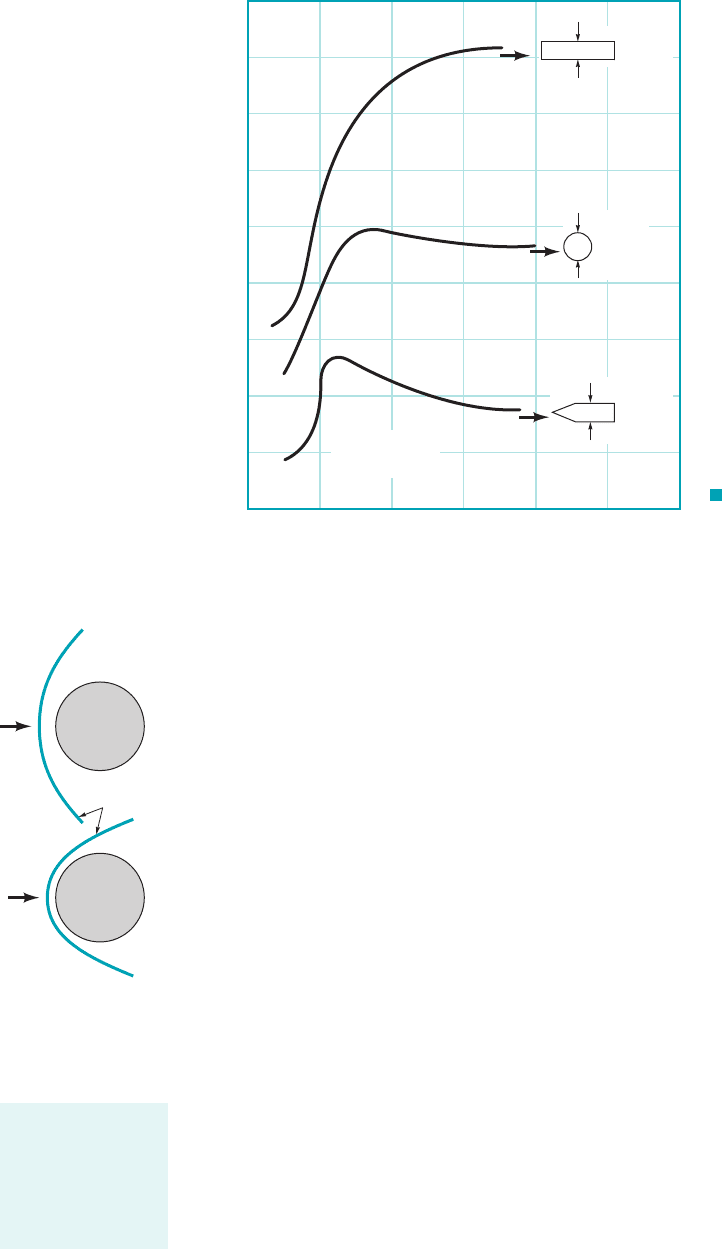
indicated by the figure in the margin. Shock waves are extremely narrow regions in the flow field
across which the flow parameters change in a nearly discontinuous manner, which are discussed
in Chapter 11. Shock waves, which cannot exist in subsonic flows, provide a mechanism for the
generation of drag that is not present in the relatively low-speed subsonic flows. (See the photo-
graph at the beginning of Chapter 11.)
The character of the drag coefficient as a function of Mach number is different for blunt bod-
ies than for sharp bodies. As is shown in Fig. 9.24, sharp-pointed bodies develop their maximum
drag coefficient in the vicinity of 1sonic flow2, whereas the drag coefficient for blunt bod-
ies increases with Ma far above This behavior is due to the nature of the shock wave
structure and the accompanying flow separation. The leading edges of wings for subsonic aircraft
are usually quite rounded and blunt, while those of supersonic aircraft tend to be quite pointed and
sharp. More information on these important topics can be found in standard texts about compress-
ible flow and aerodynamics 1Refs. 9, 10, 292.
Surface Roughness. As is indicated in Fig. 9.15, the drag on a flat plate parallel to the
flow is quite dependent on the surface roughness, provided the boundary layer flow is turbulent. In
such cases the surface roughness protrudes through the laminar sublayer adjacent to the surface 1see
Section 8.42and alters the wall shear stress. In addition to the increased turbulent shear stress, sur-
face roughness can alter the Reynolds number at which the boundary layer flow becomes turbulent.
Thus, a rough flat plate may have a larger portion of its length covered by a turbulent boundary
layer than does the corresponding smooth plate. This also acts to increase the net drag on the plate.
In general, for streamlined bodies, the drag increases with increasing surface roughness. Great
care is taken to design the surfaces of airplane wings to be as smooth as possible, since protrud-
ing rivets or screw heads can cause a considerable increase in the drag. On the other hand, for an
extremely blunt body, such as a flat plate normal to the flow, the drag is independent of the sur-
face roughness, since the shear stress is not in the upstream flow direction and contributes noth-
ing to the drag.
For blunt bodies like a circular cylinder or sphere, an increase in surface roughness can actu-
ally cause a decrease in the drag. This is illustrated for a sphere in Fig. 9.25. As is discussed in Sec-
tion 9.2.6, when the Reynolds number reaches the critical value 1 for a smooth sphere2,Re 3 10
5
Ma 1.
Ma 1
504 Chapter 9 ■ Flow over Immersed Bodies
Ma = 1.5
U
Ma = 3
U
Shock
wave
U
U
U
Circular
cylinder
D
Sphere
D
Sharp
pointed
ogive
D
C
D
=
Ᏸ
___________
U
2
D
2
1
__
2
__
4
π
0123456
Ma
0
0.2
0.4
0.6
0.8
1.0
1.2
1.4
1.6
1.8
C
D
ρ
F I G U R E 9.24
Drag coefficient as a function of
Mach number for supersonic
flow (adapted from Ref. 19).
Depending on the
body shape, an in-
crease in surface
roughness may in-
crease or decrease
drag.
JWCL068_ch09_461-533.qxd 9/23/08 11:48 AM Page 504

the boundary layer becomes turbulent and the wake region behind the sphere becomes considerably
narrower than if it were laminar 1see Fig. 9.172. The result is a considerable drop in pressure drag
with a slight increase in friction drag, combining to give a smaller overall drag 1and 2.
The boundary layer can be tripped into turbulence at a smaller Reynolds number by using a
rough-surfaced sphere. For example, the critical Reynolds number for a golf ball is approximately
In the range the drag on the standard rough 1i.e., dim-
pled2golf ball is considerably less than for the smooth ball. As
is shown in Example 9.12, this is precisely the Reynolds number range for well-hit golf balls—hence,
a reason for dimples on golf balls. The Reynolds number range for well-hit table tennis balls is less
than Thus, table tennis balls are smooth.Re ⫽ 4 ⫻ 10
4
.
1C
Drough
Ⲑ
C
Dsmooth
⬇ 0.25
Ⲑ
0.5 ⫽ 0.52
4 ⫻ 10
4
6 Re 6 4 ⫻ 10
5
,Re ⫽ 4 ⫻ 10
4
.
C
D
9.3 Drag 505
F I G U R E 9.25 The effect of surface roughness on the drag coefficient of a sphere in the
Reynolds number range for which the laminar boundary layer becomes turbulent (Ref. 5).
0.6
0.5
0.4
0.3
0.2
0.1
0
4 × 10
4
10
5
10
6
4 × 10
5
4 × 10
6
Re =
UD
___
v
Golf
ball
C
D
=
Ᏸ
___________
U
2
D
2
1
__
2
__
4
π
ε
__
D
ε
__
D
ε
__
D
ε
__
D
ε
__
D
= 5 × 10
–3
= 1.25 × 10
–2
= 0 (smooth)
= relative roughness
ρ
= 1.5 × 10
–3
GIVEN A well-hit golf ball 1diameter in., weight
2can travel at as it leaves the tee. A
well-hit table tennis ball 1diameter weight
can travel at as it leaves the paddle. U ⫽ 60 ft
Ⲑ
s0.00551 lb2
w ⫽D⫽1.50 in.,
U ⫽ 200 ft
Ⲑ
sw ⫽ 0.0992 lb
D ⫽ 1.69
S
OLUTION
Effect of Surface Roughness
while for the table tennis ball
The corresponding drag coefficients are for the stan-
dard golf ball, for the smooth golf ball, and
for the table tennis ball. Hence, from Eq. 1 for the standard golf ball
(Ans)
⫽ 0.185 lb
d ⫽
1
2
10.00238 slugs
Ⲑ
ft
3
21200 ft
Ⲑ
s2
2
p
4
a
1.69
12
ftb
2
10.252
C
D
⫽ 0.50C
D
⫽ 0.51
C
D
⫽ 0.25
Re ⫽
UD
n
⫽
160 ft
Ⲑ
s211.50
Ⲑ
12 ft2
1.57 ⫻ 10
⫺4
ft
2
Ⲑ
s
⫽ 4.78 ⫻ 10
4
E
XAMPLE 9.12
For either ball, the drag can be obtained from
(1)
where the drag coefficient, is given in Fig. 9.25 as a function
of the Reynolds number and surface roughness. For the golf ball
in standard air
Re ⫽
UD
n
⫽
1200 ft
Ⲑ
s211.69
Ⲑ
12 ft2
1.57 ⫻ 10
⫺4
ft
2
Ⲑ
s
⫽ 1.79 ⫻ 10
5
C
D
,
d ⫽
1
2
rU
2
p
4
D
2
C
D
FIND Determine the drag on a standard golf ball, a smooth
golf ball, and a table tennis ball for the conditions given. Also de-
termine the deceleration of each ball for these conditions.
Surface roughness
can cause the
boundary layer to
become turbulent.
JWCL068_ch09_461-533.qxd 9/23/08 11:48 AM Page 505

Froude Number Effects. Another parameter on which the drag coefficient may be strongly
dependent is the Froude number, As is discussed in Chapter 10, the Froude number
is a ratio of the free-stream speed to a typical wave speed on the interface of two fluids, such as the
surface of the ocean. An object moving on the surface, such as a ship, often produces waves that
require a source of energy to generate. This energy comes from the ship and is manifest as a drag.
[Recall that the rate of energy production 1power2equals speed times force.] The nature of the waves
produced often depends on the Froude number of the flow and the shape of the object—the waves
generated by a water skier “plowing” through the water at a low speed 1low Fr2are different than
those generated by the skier “planing” along the surface at high speed 1large Fr2.
Thus, the drag coefficient for surface ships is a function of Reynolds number 1viscous ef-
fects2and Froude number 1wave-making effects2; As was discussed in Chapter
7, it is often quite difficult to run model tests under conditions similar to those of the prototype
1i.e., same Re and Fr for surface ships2. Fortunately, the viscous and wave effects can often be
separated, with the total drag being the sum of the drag of these individual effects. A detailed ac-
count of this important topic can be found in standard texts 1Ref. 112.
As is indicated in Fig. 9.26, the wave-making drag, can be a complex function of the
Froude number and the body shape. The rather “wiggly” dependence of the wave drag coefficient,
d
w
,
C
D
f1Re, Fr2.
Fr U
1g/.
506 Chapter 9 ■ Flow over Immersed Bodies
for the smooth golf ball
(Ans)
and for the table tennis ball
(Ans)
The corresponding decelerations are
where m is the mass of the ball. Thus, the deceleration relative to
the acceleration of gravity, 1i.e., the number of g’s de-
celeration2is or
(Ans)
(Ans)
(Ans)
COMMENTS Note that there is a considerably smaller decel-
eration for the rough golf ball than for the smooth one. Because of
its much larger drag-to-mass ratio, the table tennis ball slows down
relatively quickly and does not travel as far as the golf ball. Note
that with the standard golf ball has a drag of
and a deceleration of considerably
less than the of the table tennis ball. Conversely, aa
g 4.77
a
g 0.202,d 0.0200 lb
U 60 ft
s
a
g
0.0263 lb
0.00551 lb
4.77 for the table tennis ball
a
g
0.378 lb
0.0992 lb
3.81 for the smooth golf ball
a
g
0.185 lb
0.0992 lb
1.86 for the standard golf ball
a
g d
w
a
g
a d
m gd
w,
0.0263 lb
d
1
2
10.00238 slugs
ft
3
2160 ft
s2
2
p
4
a
1.50
12
ftb
2
10.502
0.378 lb
d
1
2
10.00238 slugs
ft
3
21200 ft
s2
2
p
4
a
1.69
12
ftb
2
10.512
table tennis ball hit from a tee at would decelerate at a
rate of or It would not travel nearly
as far as the golf ball.
By repeating the above calculations, the drag as a function of
speed for both a standard golf ball and a smooth golf ball is shown
in Fig. E9.12.
The Reynolds number range for which a rough golf ball has
smaller drag than a smooth one (i.e., 4 10
4
to 3.6 10
5
) cor-
responds to a flight velocity range of 45 U 400 ft/s. This is
comfortably within the range of most golfers. (The fastest tee
shot by top professional golfers is approximately 280 ft/s.) As
discussed in Section 9.4.2, the dimples (roughness) on a golf
ball also help produce a lift (due to the spin of the ball) that al-
lows the ball to travel farther than a smooth ball.
a
g 54.1.a 1740 ft
s
2
,
200 ft
s
F I G U R E E9.12
1.2
1
0.8
0.6
0.4
0.2
0
Ᏸ, lb
0 100 200 400 500
U, ft/s
300
Smooth
golf ball
Standard
golf ball
Fluids in the News
Dimpled baseball bats For many years it has been known that
dimples on golf balls can create a turbulent boundary layer and re-
duce the aerodynamic drag, allowing longer drives than with
smooth balls. Thus, why not put dimples on baseball bats so that to-
morrow’s baseball sluggers can swing the bat faster and, therefore,
hit the ball farther? MIT instructor Jeffery De Tullio pondered that
question, performed experiments with dimpled bats to determine
the answer, and received a patent for his dimpled bat invention.
The result is that a batter can swing a dimpled bat approximately
3 to 5% faster than a smooth bat. Theoretically, this extra speed
will translate to an extra 10 to 15 ft distance on a long hit. (See
Problem 9.89.)
The drag coefficient
for surface ships is
a function of the
Froude number.
V9.12 Jet ski
JWCL068_ch09_461-533.qxd 9/23/08 11:48 AM Page 506
